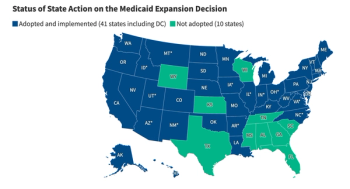
Personal prevention: Christopher Fey shows why detection and chronic condition management is powerful medicine
According to the 2007 Milken Institute Report, "An Unhealthy America: The Economic Burden of Chronic Disease," prevention, early detection and chronic condition management could save the nation $1 trillion annually by 2023. But in the mind of U.S. Preventive Medicine Founder (USPM), Chairman, CEO and Director Christopher Fey, there is something even more important that could be saved: lives.
When Fey was just one year old, his father died from colon cancer at the age of 29. "I never knew him," Fey says. "Growing up without a father is not easy."
While this tragedy greatly influenced Fey's involvement in healthcare, another family member's near death may have been the tipping point.
At that time, Fey was the founder, president and CEO of HealthCare USA, a 115,00-member HMO, in Jacksonville, Fla. "My doctor had to remind me-a managed care executive-that he couldn't order but the most basic tests-the 'system' wouldn't allow it," he says. "We have the misconception that doctors are acting as our personal health architects and mapping out our personal prevention plans and maximizing the quality of life. In reality, the average doctor visit lasts under 10 minutes. Most of that time is spent on diagnosing and treating a problem."
The United States operates the most sophisticated and expensive "sick care" system in the world, according to Fey. "The problem is that symptoms present at the later stages of disease, not the early stage of disease when interventions can usually-not in all cases, but usually-provide better outcomes and reduced costs. The true innovators in medicine predict that the future of medicine will be all about prevention, early detection and chronic condition management."
Q. Give a big picture overview of what prevention means for cost, quality and outcomes for executives.
A. definition of prevention is in order here. There are several components to prevention. Primary prevention is focused on not becoming ill or injured. This is about immunizations, wearing seat belts, following a personal health and wellness lifestyle that enhances one's well being, as well as early detection through the use of appropriate screening tests. Prevention also encompasses secondary prevention, that is, the proper management of illness and chronic conditions so that outcomes are improved. Prevention is powerful medicine, and it pays generous rewards.
Now for the question about the impact of prevention on cost, quality and outcomes. First, according to the Milken Report issued in 2007, prevention, early detection and chronic condition management could save the nation $1 trillion annually by 2023. Second, if you attend the American College of Occupational and Environmental Medicine's meetings or those of the American College of Preventive Medicine, or the regional or health coalition groups across the country, or the chamber of commerce meetings, the discussions and presentations are all about looking for a prevention solution as the only way out of the healthcare crisis. Trying to sell a health benefit without a strong focus on prevention would be like trying to sell a car with out a steering wheel.
Managed care executives who realize prevention is powerful medicine will recast their companies in the light of what baby boomers are going to want to buy-none of them want to get sick; they are going to want more focus on prevention-and if they do come down with a chronic condition, they want great clinical care, excellent customer service and help managing that condition-all at a cost they can understand.
Newsletter
Get the latest industry news, event updates, and more from Managed healthcare Executive.





















































